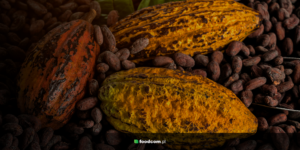- The cocoa market in 2025 is stabilizing after the crisis, but prices remain at historically high levels.
- Traceability and EUDR regulations are becoming key factors shaping global cocoa trade.
- The geography of supply is changing, with Latin American producers gaining in importance at the expense of West Africa.
The year 2025 marks a clear turning point for the global cocoa market. After two seasons of weather disruption and historically high prices, the market is gradually beginning to recover, although cost levels remain well above the averages of previous years. At the same time, the industry is facing a permanent change in structure – the importance of full traceability, certification and the premium segment is growing, and the geography of supply is gradually diversifying. This analysis outlines the key mechanisms shaping the situation in 2025 and the key trends affecting the market outlook in 2026. .
Global cocoa market analysis
The global cocoa market remains tight in 2025, although it is moving from a phase of acute crisis to a phase of more expensive but more stable normality. Following a poor harvest in West Africa, the market experienced historic price increases in 2024, with cocoa becoming one of the world’s best performing commodities. In 2025, forecasts point to a recovery in supply and a slight surplus, but prices are still well above the levels of the last decade.
On the supply side, West Africa dominates, especially Côte d’Ivoire and Ghana, together accounting for more than two-thirds of global production. In parallel, there is a growing role for Latin America, particularly Ecuador, which is building a position as the main source of fine flavour cocoa and an increasing share of bulk supply. The market is therefore clearly divided into bulk cocoa and the premium/single-origin segment.
On the demand side, new applications are growing in importance: better-for-you snacks, high-protein products, functional drinks and dietary supplements. High prices are forcing manufacturers to reformulate and downsize, while accelerating premiumisation. Consumers accept higher prices in single-origin, high-cocoa content and bean-to-bar segments.
Certified and traceable cocoa is growing in importance. In 2025, traceability requirements are becoming standard, with EUDR regulation playing a key role, requiring evidence of no deforestation and full documentation of the source of raw material.
Regional analysis of the cocoa market
The structure of the market varies significantly by region, both in terms of the nature of supply and the dynamics of demand, regulatory requirements and the role of premium and certified segments.
Europe
Europe remains a key market in terms of both processing and consumption, with a dominant influence on global quality and sustainability standards. The Netherlands, Germany and Belgium account for the largest share of European cocoa milling, and their plants are the main entry point for raw material from Africa and Latin America.
In 2025, volume demand in Europe is stable, but consumers are clearly shifting towards premium, high-end and single-origin products. In addition, European retail is increasingly demanding ‘zero-deforestation compliance’, detailed batch documentation and farm geolocalisation from suppliers, redefining the supply chain in practice. In the private label sector, certified cocoa (RA, Fairtrade) is becoming the standard, and in industrial production, raw material with full traceability.
It is worth noting that Europe is the region with the strongest ‘regulation-driven demand’. It is the European quality and environmental requirements that set the stage for global change, and producers outside the EU are adapting their systems in terms of the EUDR, even if they also sell to other regions.
West Africa
West Africa, primarily Côte d’Ivoire, Ghana, Nigeria and Cameroon, accounts for more than two-thirds of the world’s cocoa supply and remains the cornerstone of the global market. In 2025, the region continues to suffer from past yield losses caused by weather anomalies, soil degradation and plantation diseases. Yields are lower than expected and many plantations require rehabilitation, which farmers often cannot afford at current production costs.
One of the most important processes is the digitisation of the supply chain. Countries are implementing producer registers and plot mapping to meet EUDR requirements. This is a huge operational change: thousands of small farmers are being put into official databases and trade is increasingly taking place through licensed co-operatives or large exporters. This has implications for the structure of trade. The role of informal intermediaries is diminishing and raw material without documentation of origin is losing access to premium markets.
Despite the structural problems, West Africa is still irreplaceable in terms of volume, but the risk that without plantation modernisation and farmer support, the region may gradually lose share to Latin America is becoming increasingly apparent.
North America
The US and Canada are some of the most profitable markets for cocoa, characterised by high price acceptance in the premium segment and strong dynamics in functional categories. North American buyers are increasingly demanding not only responsible sourcing certificates from suppliers, but also documented ESG data on farmers’ working conditions, farmer income levels and the environmental impact of plantations.
Following the 2024 price hike, consumers in the US have partly accepted more expensive chocolates, and manufacturers have introduced recipe changes and downsizing in an effort to maintain margins. The premium, high cocoa content, single-origin, bean-to-bar segment has seen growth, while the mass market segment remains more price sensitive. Also important is the growing interest in cocoa as a functional ingredient: extracts rich in flavonols are appearing in supplements, wellness drinks and sports products.
Latin America
Latin America is the region with the fastest growth in global supply in 2025. Ecuador, Brazil, Colombia and Peru are increasing crop acreage, yields and share of premium markets. Ecuador stands out for its high productivity and investment in agroforestry, which improves crop resilience to climate change and facilitates compliance with EUDR requirements.
The region is particularly important for the fine flavour segment: the Nacional/Arriba varieties and other local genotypes provide the flavour profile that the premium sector is looking for. A bean-to-bar sector is also developing in many countries, building recognition of regional terroirs and increasing export value.
Looking ahead to the next few years, Latin America could be the biggest beneficiary of the growing demand for cocoa that is certified, transparent and easier to audit.
Asia
Asia has a dual role: it is growing as a producer, but even faster as a consumer. Indonesia remains the region’s largest producer, although its share of the global market has declined over the past decade due to competition from other crops. The Philippines, Vietnam and Malaysia are increasing production, often in agroforestry systems, to enter the premium segment.
Demand is growing rapidly. most notably in China and India, where chocolate is undergoing a transformation from an occasional good to an everyday product for the growing middle class. In Japan and Korea, the ‘high cacao, low sugar’ trend is strong, increasing demand for higher quality cocoa.
Asia is also an important importer of cocoa from Latin America, particularly in the artisan and single-origin segments, further stimulating global competition for premium raw material.
Middle East and North Africa
The MENA region remains heavily dependent on imports of cocoa and intermediates. High consumption of confectionery, especially during festive periods, keeps demand stable even at higher prices. In particular, the UAE, Saudi Arabia and Qatar are developing the premium and luxury segment, while Egypt and Morocco are focusing on mass products.
There is a growing demand for halal, organic and fair-trade certified cocoa in the region, and consumers are increasingly interested in transparency of origin. MENA is also very sensitive to logistics costs: changes in freight rates and the dollar exchange rate affect the structure of imports, sometimes shifting purchases between West Africa and Latin America.
Trends and forecasts
The most important development in 2025 is the transition of the cocoa market from a phase of acute deficit to one of limited but stabilising supply. Forecasts for 2026 indicate a gradual recovery in production, especially outside West Africa, and a moderate normalisation of prices, although they are likely to remain above the levels of the last decade. In the baseline scenario, global consumption is assumed to grow at a rate of a few per cent per annum, with market values growing faster thanks to continued high raw material costs and growth in the premium segment.
The second key trend is the strengthening of traceability and environmental responsibility requirements. The EUDR is becoming a market benchmark and is forcing investment in farm mapping, batch tracking systems and audits. For many buyers, it is no longer just the physical quality of the raw material that matters, but also complete documentation of origin and evidence of no deforestation.
The third element is the geographical shift in supply. West Africa remains key, but its structural problems favour a growing role for Latin America and selected Asian countries, especially where traceability and production requirements in agroforestry systems are easier to meet. Ecuador and other Latin American producers are intensively increasing acreage, yields and share of premium cocoa.
The fourth trend is the polarisation of chocolate consumption. The ‘pure indulgence’ segment is sustained by high-indulgence and premium products, while ‘conscious choices’ focus on composition, lower sugar content and certifications. In between, the ‘balance’ segment is developing, combining indulgence with better composition, which is changing the requirements for quality and origin of raw material.
The fifth direction remains the professionalisation of production in the countries of origin. The rise of better organised co-operatives and processors working to BRC, IFS or bio standards stabilises quality and makes it easier to meet market requirements. An increasing number of countries are also investing in local production of pulp, butter and powder, which is gradually shifting trade away from grain exports towards exports of higher value-added intermediate products.


In 2025, the cocoa market has finally started to cool down after last year’s historic price surge, although it has not returned to its former equilibrium. The entire supply chain now operates according to a new logic, in which reliable information about the origin of the raw material counts almost as much as its price. Although the formal entry into force of the EUDR regulations has been delayed, they are already forcing changes and preparations on the part of producers and processors, making full traceability a practical market standard. At the same time, cocoa supply remains very inelastic and even very high prices cannot quickly translate into increased production, as new plantings take years to start bearing fruit. As a result, any sustained increase in demand for premium or certified cocoa immediately puts further upward pressure on prices. The market is entering a phase of clear segmentation and increasing sensitivity to quality and transparency, and these factors will shape the coming seasons.
Moreover, the recent correction in cocoa prices may favour a renewed upturn in sales of chocolate products, as lower raw material costs should gradually translate into retail prices. This, in turn, could stimulate consumer demand and provide short-term support for the processing sector, even though the industry is still operating in the reality of a new, more challenging supply structure and increasing traceability requirements.”
Global Reports from Foodcom S.A.
Curious about what’s next for cocoa? Discover the latest trends and insights that will shape 2026. Visit our blog as we regularly update our global reports. Stay up to date with Foodcom S.A.
![Cocoa market overview 2026 [Global Report] Cocoa market overview 2026 [Global Report]](https://foodcom.pl/wp-content/uploads/2025/11/global-report-Cocoa-2025-min.png)







